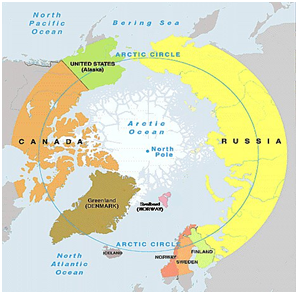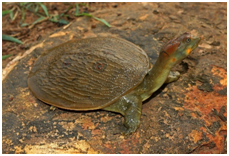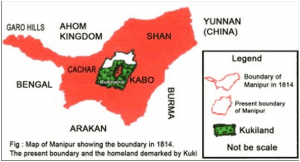INTERNATIONAL RELATIONS
1. RUSSIA’S NUCLEAR ICEBREAKERS AND MILITARISATION OF THE ARCTIC
THE CONTEXT: Recently, Russian President virtually presided over the launch and flag raising ceremony of two nuclear-powered icebreakers at St. Petersburg and said such icebreakers were of “strategic importance”. As climate change opens up the Arctic giving access to new routes and resources, there is a race by adjoining countries to build up their militaries and Russia has a clear lead over them.
THE EXPLANATION:
Why are the Russian icebreakers significant?
- According to the President, the icebreakers were laid down as part of their large-scale, systematic work to re-equip and replenish the domestic icebreaker fleet, to strengthen Russia’s status as a “great Arctic power.” The 173.3-metre-long‘Yakutia’, with a displacement of up to 33,540 tonnes, was launched into water and can break through three metres of ice.The flag was raised on another vessel Ural, which is expected to become operational in December, while the Yakutia will join service by end-2024.
- There are two already similar vessels in service, Arktika and Sibir. He said that a much more powerful 209-metre-long nuclear icebreaker “Rossiya,” displacing up to 71,380 tonnes, would be completed by 2027. In the last two decades, Russia has reactivated several Soviet era Arctic military bases and upgraded its capabilities.
Why are countries racing towards the Arctic?
- There has been a race among Arctic states and near-Arctic states to augment their capabilities in a bid to be ready to capitalise on the melting Arctic. Russian military modernisation in the Arctic has prompted other Arctic states to join the band wagon. Unlike Antarctica, the Arctic is not a global common accentuating the problem.
- For instance, the North Atlantic Treaty Organisation (NATO) has been conducting regular exercises in the region while partner countries are investing in upgrading military capabilities. At the same time, China, which calls itself to be a near-Arctic state, has also announced ambitious plans for a ‘polar silk route’ to connect to Europe as well building massive icebreakers.
Where does India stand with respect to the Arctic?
- Since 2007, India has an Arctic research programme with as many as 13 expeditions undertaken till date. In March 2022, India unveiled its first Arctic policy titled: ‘India and the Arctic: building a partnership for sustainable development’. India is also one of the 13 Observers in the Arctic Council, the leading intergovernmental forum promoting cooperation in the Arctic.
- As the earth further heats up, which is more profound at the poles, the race for the Arctic is set to accelerate which makes the Arctic the next geopolitical hotspot with all interests converging on it – environmental, economic, political and military.
VALUE ADDITION:
ARCTIC COUNCIL:
- It is an intergovernmental forum for discussing and resolving issues related to the Arctic
 region. The issues may include scientific research and the peaceful and sustainable use of resources in the region.
region. The issues may include scientific research and the peaceful and sustainable use of resources in the region. - It works on the overall objective of conserving the pristine environment, biodiversity and the interests and well-being of the local populations.
- It is not a treaty-based international legal entity like the UN organisations or trade or regional groupings such as NATO or ASEAN.
- It was set up by the 8 Arctic countries by means of the Ottawa Declaration of 1996. These countries are the US, Canada, Russia, Iceland, Denmark, Sweden, Norway, and Finland.
- In addition to these countries, 6 organisations representing the indigenous people of the Arctic region have also been given the status of permanent participants.
2. INDIA-AUSTRALIA TRADE PACT
THE CONTEXT: The Australian Parliament recently approved the free trade agreement with India. In India, such agreements require approval from the Union Cabinet.
THE EXPLANATION:
What is AI-ECTA?
- The Australia-India Economic Cooperation and Trade Agreement (AI-ECTA) was signed by the two countries on April 2, 2022.
- This free trade agreement eases trade between India and Australia by reducing customs duties, regulatory laws, subsidies and quotas on products under import-export.
- The pact ensures that the cost of production is cheaper when compared with other countries.
Why is AI-ECTA significant?
- AI-ECTA is the first free trade agreement that India signed with a large developed economy in the last decade.
- Besides AI-ECTA and an FTA with Japan, all of India’s FTAs are with other developing countries like Singapore, South Korea, ASEAN, Malaysia and UAE.
- Once it becomes operationalized, AI-ECTA will provide India a duty-free access to Australian market for over 6,000 broad sectors. These include textile, leather, furniture, jewellery, machinery and others.
- It will help Australia reduce its dependence on Chinese market and forge new bilateral trade ties.
- Under this free trade agreement, Australia will provide zero-duty access to India for some 96.4 per cent (by value) of its exports. This includes products that currently incur 4 to 5 per cent customs duty in Australia.
- Numerous labour-intensive sectors in India are expected to benefit from this trade pact. These include textile and apparel, agricultural and fish products, leather, footwear, furniture, sports goods etc.
- India exported to Australia goods worth 8.3 million USD in 2021-22. India’s imports from Australia was at 16.75 billion USD during this period. The FTA will increase the bilateral trade value from the present 27.5 billion USD to 45-50 billion USD in the next five years.
- It will enhance people-to-people relations and foster cultural ties between the two countries.
- It will increase access to a range of skilled service providers, investors and business visitors, boosting investments and business opportunities significantly.
VALUE ADDITION:
PRELIMS PERSPECTIVE
IFC-IOR: The Information Fusion Centre – Indian Ocean Region in Gurugram is an Indian initiative to boost maritime security and response through the exchange of information related to the ships in the Indian Ocean Region.
Strategic Dialogue In June 2020, Australia and India decided to upgrade their Secretaries 2+2 dialogue (Defence and Foreign Affairs) to the Ministerial level.
Exercise Malabar: Australia participated in the MALABAR naval exercise in October 2020, joining India, the United States, and Japan.
AUSINDEX: Engagement between the Royal Australian Navy and the Indian Navy has advanced significantly through the key bilateral exercise, AUSINDEX.
Pitch Black: For the first time, the Indian Air Force participated in Exercise Pitch Black in Darwin in 2018.
ENVIRONMENT, ECOLOGY AND CLIMATE CHANGE
3. LEITH’S SOFTSHELL TURTLE
THE CONTEXT: India’s proposal to increase the protection of Leith’s softshell turtle was approved at the 19th Meeting of the Conference of the Parties (CoP 19) to the Convention on International Trade in Endangered Species of Wild Fauna and Flora (CITES), which is being held in Panama City from November 14 to 25.
THE EXPLANATION:
About Leith’s Softshell Turtle
- Leith’s softshell turtle is a large freshwater soft-shelled turtle that is endemic to peninsular India.
- It has been subject to intense exploitation over the past 30 years for poaching and illegal consumption within India. It has been illegally traded to foreign countries for meat and its calipee.
- This species’ population has fallen by 90 per cent over the past 3 decades and is now very difficult to find.
- It is classified as “critically endangered” in the IUCN Red List.
- The turtle has been listed on Schedule IV of the Wild Life (Protection) Act, 1972, which gives protection from hunting and trading. However, this protection failed to save the species from poaching and illegal trade. Seizures of thousands of specimens are reported every year.
- The recent shift from CITES Appendix II to Appendix I will help prevent commercial trade of this critically endangered species. It will ensure that the international trade of captive-bred specimens only takes place in registered facilities and that higher and more appropriate penalties are given for illegal trade.
What are the other key outcomes of COP19 of CITES?
- At the conference, 52 proposals have been put forward to increase regulation of the international trade of sharks, reptiles, hippos, songbirds, rhinos, 200 tree species, orchids, elephants, turtles etc.
- India also proposed induction of freshwater turtle Batagur kachuga, which gained widespread support from the parties in COP19 of CITES.
- During the event, CITES lauded and recorded India’s efforts focusing on the conservation of tortoises and freshwater turtles as well as the efforts towards combating wildlife crime and the illegal trade of turtles. It specifically recognized the positive outcomes of Operation Turtshield, which resulted in the capturing of numerous criminals involved in the poaching and illegal trade of freshwater turtles and the large number of seizures made in different parts of the country.
SECURITY AFFAIRS
4. KUKI-CHIN BANGLADESHI REFUGEE ISSUE
THE CONTEXT: The on-going conflict between Bangladeshi security forces and the Kuki-Chin National Army (KNA) triggered an influx of refugees from the Kuki-Chin community to the Indian state of Mizoram.
THE EXPLANATION:
Who is Kuki-Chin National Army (KNA)?
- The Kuki-Chin National Army (KNA) is the armed wing of the Kuki-Chin National Front (KNF) – a separatist group that was established in 2008 to create a separate state in Chittagong Hill Tracts (CHT) in Southern Bangladesh.
- The KNF claims that all members of the Bawm, Pungkhua, Lushai, Khumi, Mro, and Khyang ethnic groups are part of the greater Kuki-Chin race.
- Also known as the Bawm Party, this group is having close relationships with rebel groups in Northeast India and Myanmar.
About the current conflict in Bangladesh
- The Rapid Action Battalion (RAB) has launched an operation in October 2022 against the Kuki-Chin National Army (KNA) after it entered into an agreement with the newly formed militant outfit called the Jama’atul Ansar Fil Hind al Sharqiya, which originated from the remote hilly terrains of Rangamati and Bandarban. Under this three-year agreement, KNF will provide shelter, training and other support to the militants in return for 3 lakh Bangladeshi Taka and food expenditure. While several of them have been arrested, 50 militants are currently being trained in the region.

Refugee Situation in Mizoram
- This on-going military operation in the CHT has triggered the inflow of refugees in Mizoram. At least 200 Kuki-Chin refugees from Chittagong reached Mizoram’s Lawngtlai district.
- The state cabinet had recently approved the setting up of temporary shelters and other basic amenities the Bangladeshi Kuki-Chin refugees. Some 35 lakh people of Kuki-Chin-Mizo communities live in Chittagong Hills Tracts. More refugees from this region are expected to reach Mizoram.
- They will be recognized as “officially displaced persons” in the state government records since there are no laws related to refugees in India. These refugees will be housed on the same lines as the shelters given to the refugees from Myanmar, who entered Mizoram after the 2021 coup. Mizoram, which shares a 318-km-long border with Bangladesh, currently hosts some 30,000 refugees from Myanmar.
GOVERNMENT SCHEMES AND INITIATIVE IN NEWS
5. FOOD SAFETY AND STANDARDS (GM FOODS) (DRAFT) REGULATIONS
THE CONTEXT: The FSSAI recently released a new draft of Genetically Modified (GM) Food regulations for public consultation. This comes at a time when the issue concerning the genetically modified (GM) mustard is under the spotlight.
THE EXPLANATION:
About the new draft regulations:
- The new draft is different from the old version that was released by the Food Safety and Standards Authority of India (FSSAI) in November 2021. The recently-released draft aims to simplify the procedure of prior approvals for food that are derived from genetically modified organisms (GMOs). It also expands the scope of regulations by including food ingredients produced from GMOs that do not have any modified DNA.
What does the draft regulations propose?
- The draft regulations propose front-of-the-pack labelling of packaged food products that contain 1 per cent or more of GM ingredients.
- It is applicable for genetically modified organisms (GMOs) used in food items having 1 per cent or more of GM ingredients produced from modified DNA and GMO-derived ingredients, additives or processing aids.
- No one will be allowed to manufacture, pack, store, sell, market, distribute or import any food items produced from GMOs, except those that have received prior approval from the FSSAI.
- Manufacturers and importers of genetically modified food products and ingredients are required to receive approval from the food regulator.
- If the GMOs are used as food or source material for the production of food, clearance is required from the Genetic Engineering Appraisal Committee (GEAC) – the central government authority responsible for monitoring the environmental risks posed by the GMOs.
- If the genetically modified organism is used as seeds or for cultivation, the applicant is required to submit an application to the GEAC to comply with the Environment Ministry’s 1989 rules.
- Food products having individual 1 per cent or more GM ingredients must be labeled as “contains genetically modified organisms”. This label must be at front of the pack of pre-packaged products. This rule is also applicable to the presence of adventitious or technically unavoidable presence of GM ingredients.
MISCELLANEOUS
6. INDIA WINS THE INTERNATIONAL ELECTROTECHNICAL COMMISSION (IEC) VICE PRESIDENCY CHAIR
THE CONTEXT: India wins the International Electrotechnical Commission (IEC) Vice Presidency and Strategic Management Board (SMB) Chair for the 2023-25 term.
THE EXPLANATION:
- By securing over 90% of the votes cast by full members of International Electrotechnical Commission (IEC) during its General Meeting held recently in San Francisco, USA, India’s representative, a member of the Indian National Committee of the International Electrotechnical Commission (IEC) and various technical committees of Bureau of Indian Standards (BIS-India), was elected.
- Representation of BIS (India) in policy and governance bodies of International Organization for Standardization (ISO) and IEC ensures that Indian viewpoints on the important strategic and policy matters are put forth and it also provides opportunities to align the national standardization priorities with International best practices.
- Currently, BIS (India) is represented in various policy and governance bodies of International Organization for Standardization (ISO) and IEC such as ISO Council, ISO Technical Management Board (TMB), IEC SMB, IEC Market Strategy Board (MSB), IEC Business Advisory Committee (BAC), etc.
International Electrotechnical Commission (IEC):
- Founded in 1906, the IEC (International Electrotechnical Commission) is a global, not-for-profit membership organization that brings together more than 170 countries and coordinates the work of 20 000 experts globally. It is the world’s leading organization for the preparation and publication of international standards for all electrical, electronic and related technologies, collectively known as “electrotechnology”.
- The mission of the IEC is to achieve worldwide use of IEC International Standards and Conformity Assessment systems to ensure the safety, efficiency, reliability and interoperability of electrical, electronic and information technologies, to enhance international trade, facilitate broad electricity access and enable a more sustainable world.
Headquarters: Geneva, Switzerland.
THE PRELIMS PRACTICE QUESTION
QUESTION OF THE DAY
Q1. Consider the following statements:
- India has Observer status in the Arctic Council.
- ‘Maitri’ is India’s permanent Research Centre in Arctic region.
Which of the statements given above is/are correct?
a) 1 only
b) 2 only
c) Both 1 and 2
d) Neither 1 nor 2
Answer: A
Explanation:
- Statement 1 is correct: Arctic Council is a high-level intergovernmental body set up in 1996 by the Ottawa declaration to promote cooperation, coordination and interaction among the Arctic States together with the indigenous communities and other Arctic inhabitants. Canada, the Kingdom of Denmark, Finland, Iceland, Norway, the Russian Federation, Sweden and the United States of America are members of the Arctic Council. India recieved Observer status in the Arctic Council in 2013.
- Statement 2 is incorrect: ‘Himadri’ is India’s first permanent research centre in Arctic region.

